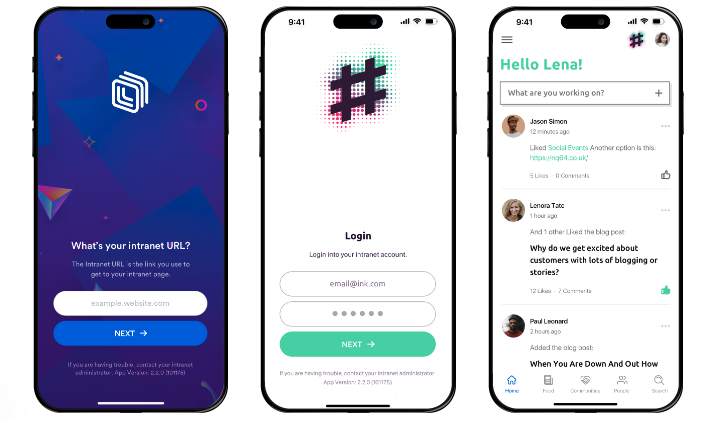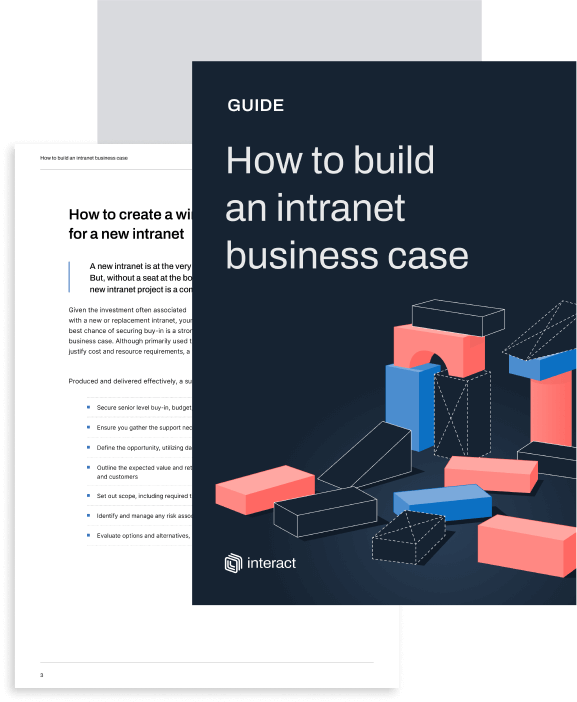If your intranet feels stuck in the past, you risk diminishing employee productivity, collaboration, and communication, all of which are crucial for organizational success. In this article, we explore modern intranet considerations and features.
The heartbeat of organizational connectivity lies within the modern intranet. Yet, as employee needs evolve and organizational requirements continually shift, many companies find their intranets lagging behind, burdened by outdated features and functionalities.
According to Gallup, only around one quarter of workers feel strongly connected to their organization’s mission and purpose, the lowest rate they’ve measured in over a decade.
McKinsey found similarly concerning levels of disconnection among the workforce, with only 9% of frontline workers feeling more connected to their networks in the past few years, compared to 22% of middle managers and 45% of senior leaders.
If this sounds familiar, then it’s time to breathe new life into your internal communication platform, transforming it into a dynamic hub that not only facilitates communication but also nurtures collaboration, innovation, and employee engagement. There is much to be gained: The organizations that succeed at connecting employees can increase employee performance by up to 37% and retention by up to 36% (Gartner).
Join us on a journey to revitalize your intranet, exploring essential upgrades and uncovering the transformative power of a fully-fledged Employee Experience (EX) platform.
The role of the modern intranet

Modern intranets address a variety of employee needs through a wide range of capabilities. Not all organizations will have the exact the same requirements from their intranets, but many now rely on them for the following purposes:
- Information sharing
- Knowledge management
- Internal communications
- Enterprise social networking
- Employee lifecycle managing
- Task completion and workflows
- Employee idea management
- Measuring and improving engagement
- Celebrating brand identity and company culture
- Rewards and recognition
Before you settle on an intranet upgrade for your organization, it’s important to understand what employees need from it. Are employees struggling to locate critical information? Do silos exist between departments hindering collaboration?
Building an intranet business case
Conduct surveys or focus groups to identify their pain points and gather insights into the information they access most frequently. Analyzing current communication patterns and information flow within the organization will further inform the functionalities and features that will be most valuable to your workforce.
With this understanding of employee needs, you can define clear, employee-centric objectives for your intranet that align with and support overarching business goals.
The objectives typically fall into two main categories:
1. Generic modern intranet objectives
These high-level goals may be more challenging to quantify, but they are essential for the success of your intranet. Examples include:
- Enhancing internal communication
- Facilitating collaboration between teams
- Driving employee engagement
2. Specific modern intranet objectives
These measurable, quantifiable targets provide a clear focus for your intranet strategy. Examples of specific objectives could be:
- Reducing all-company email volume by 70%
- Decreasing IT workload by 50% through the implementation of a self-service knowledge base
- Improving eNPS response rates by 80% within a 12-month period
To ensure your intranet delivers comprehensive value, it’s important to incorporate both generic and specific objectives into your planning process.
Building an intranet business case
The next step is to translate these objectives into actionable features and solutions for your new intranet. By focusing on high-value intranet capabilities, you’ll create a digital workspace that effectively supports your team and drives organizational success. Prioritize the elements that will have the greatest positive impact on your employees, such as:
- Robust search functionality
- Efficient content management workflows
- Responsive design optimized for various devices
- Interactive social features to encourage connection and collaboration
- Dedicated spaces for project collaboration and community building
- Engaging video communication tools for information sharing and inspiration
- Meaningful employee recognition features to celebrate achievements
Once you’ve aligned on solutions to prioritize, implementing a proof of concept (POC) can be a low-risk way to test the feasibility and potential impact of the new platform.
An intranet POC is a limited, early-stage version of the eventual intranet that allows you to accomplish specific objectives and understand how the platform will work in your organization’s context. While not always necessary, a POC can be particularly valuable for large enterprises or complex use cases.
To get the most out of an intranet POC, keep the trial period restricted, limit the number of stakeholders involved, plan user journeys and permissions carefully, identify specific features and functions to test, and set up test scripts with predefined content and interactions.
Keep in mind that a POC has limitations and won’t fully represent the final intranet experience, but it can still provide valuable insights to guide your decision-making and ensure your new intranet delivers on your organization’s objectives.
Intranet features to bring your digital workplace up to date
Your digital workplace – and digital company culture (DEX) as a whole – can greatly benefit from an updated feature set. This could require speaking with your current intranet provider about add-on features which they may charge you extra for.
Alternatively, you could move to a new intranet solution from a vendor such as Interact that provides a diverse feature set right out of the box, can ensure a smooth migration to the new platform, and also has an exciting product roadmap in place.
Let’s break down the popular types of intranet features that leading enterprises commonly implement:
Accessibility and content management
- Mobile accessibility: Today’s workforce is constantly on the go. Your intranet should be accessible on mobile devices like smartphones and tablets, designed to be user-friendly for those on the go, allowing employees to stay connected and informed from anywhere.
- Easy content creation: Empowering employees to contribute content fosters a sense of ownership and keeps information fresh. Look for features that allow for easy creation and editing of documents, news articles, or announcements. Consider AI-powered content creation tools that can assist with tasks like summarizing complex documents or generating drafts.
- Search functionality: A robust search engine is crucial for navigating the vast amount of information on your intranet. Ideally, it should seamlessly search across internal content and even integrate with third-party document management systems for a truly comprehensive search experience.
- Employee directory: A searchable employee directory allows employees to quickly find contact information for colleagues across departments, promoting collaboration and communication.
- Integrations with third-party tools: The ability to integrate with existing third-party tools like project management software, HR systems, or document management systems can streamline workflows and improve overall user experience.
Building an intranet business case
Communication and connection
- Multichannel communication: A modern intranet should support various communication channels beyond just static text. Features like internal chat, video conferencing, or discussion forums can facilitate dynamic information exchange and real-time collaboration.
- Personalized content: Tailoring content – and the delivery of it – based on individual roles, departments, or interests keeps employees engaged with relevant information. AI-powered personalization can take this a step further by analyzing user behavior and preferences to automatically suggest content, news, or updates that are most likely to be of interest to each employee.
- Social features: Employee profiles, activity feeds, and social recognition can offer a familiar way for teams to engage, further fostering a sense of connection and community within the organization. These features allow employees to share knowledge, celebrate successes, and build stronger relationships with colleagues.
- Email newsletters: Regularly scheduled email newsletters can keep employees informed about company news, upcoming events, and important announcements. This can be a good way to reach employees who may not actively use the intranet on a daily basis.
- Discussion forums and communities: Facilitating dedicated spaces for topic-specific discussions or employee groups can foster knowledge sharing, collaboration, and a sense of community.
Engagement and feedback
- Onboarding: A well-structured onboarding program can significantly improve employee experience and retention. Your intranet can serve as a central hub for onboarding materials, resources, and FAQs, ensuring a smooth transition for new hires.
- Recognition and advocacy: Recognizing and celebrating employee achievements publicly can boost morale and motivate others. Look for features that allow for peer-to-peer recognition or social advocacy tools that empower employees to share company news and accomplishments on their social media platforms.
- Idea management and survey tools: Encouraging employee participation and capturing valuable ideas is key to innovation. Consider features like idea boards, suggestion boxes, or pulse surveys to gather employee feedback and foster a culture of continuous improvement.
- Analytics: Data-driven insights are crucial for measuring the effectiveness of your intranet. Analytics tools can track user engagement, content performance, and overall platform usage, allowing you to refine your strategy and optimize the intranet for maximum impact.
By incorporating these features, you can create a modern intranet that empowers your employees, fosters collaboration, and drives success for your organization.
Keeping your modern intranet dynamic and responsive

While launching a modern intranet is a significant step forward, it’s just the beginning of your journey towards a truly connected and engaged workforce. The key to long-term success lies in cultivating a thriving digital workplace culture.
This means fostering a mindset where employees actively participate in contributing content, sharing knowledge, and utilizing the collaborative features available on the intranet. Regularly solicit feedback through surveys, focus groups, or even dedicated intranet channels to ensure the platform continues to meet employee needs and remains a relevant resource.
Remember, a successful intranet is a living entity that should evolve alongside your organization. By prioritizing employee needs, fostering a culture of continuous improvement, and remaining data-driven in your approach, you can transform your intranet into a powerful tool that fuels innovation, boosts employee engagement, and propels your organization towards achieving its strategic goals.


